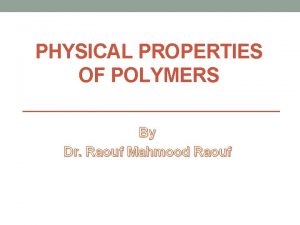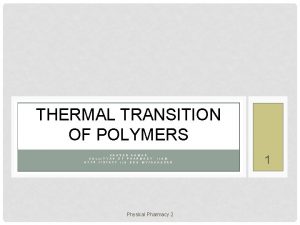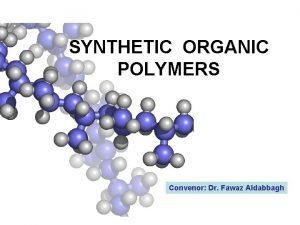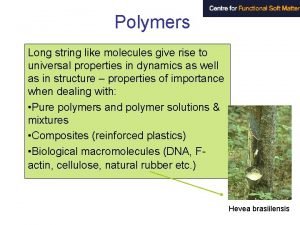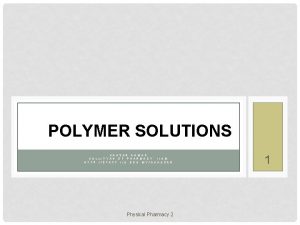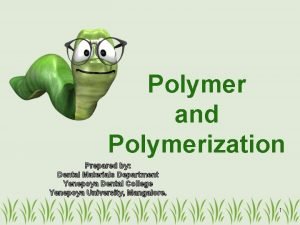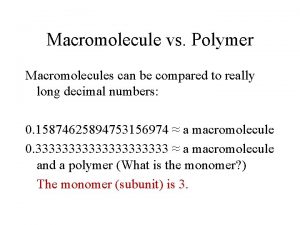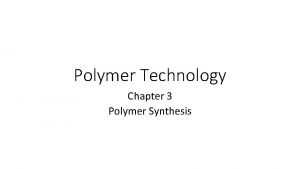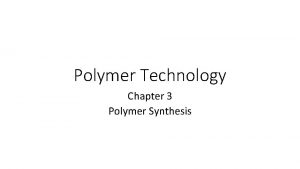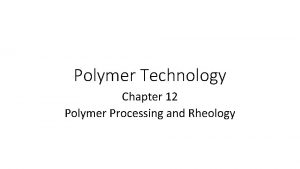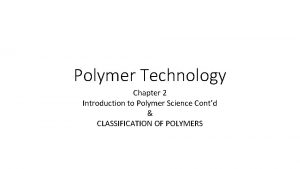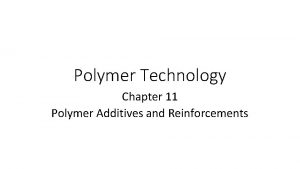Polymer Technology Chapter 9 SolidState Properties SolidState Properties












- Slides: 12

Polymer Technology Chapter 9 Solid-State Properties

Solid-State Properties Effect of Molecular Weight and Composition on Tg • Molecular-Weight Dependence: The glass-transition temperature ‘Tg’ tremends up with molecular weight at low molecular weight values but the glass-transition temperature reaches a point at moderate molecular weight where further increase in molecular weight value does not affect the glass-transition temperature ‘Tg’. • This is an example of a limiting-property relationship observed with the relation between the glass-transition temperature and the molecular weight of the macromolecule. • The crystalline-melting temperature, Tm, follows a similar dependence on molecular weight as the glass transition temperature follows. • This dependence of the melting temperature on the molecular weight can be rationalized on the basis of the free-volume theory of the glass transition.

Solid-State Properties Effect of Molecular Weight and Composition on Tg • Larger free volume is associated with the ends of long macromolecule chains than with other chain segments, then the free volume goes up with an increasing number of chain ends, which means that a decrease in the molecular weight.

Solid-State Properties Effect of Molecular Weight and Composition on Tg • The form of dependence of the glass transition temperature ‘Tg’ on the molecular weight can be approximated by the Fox–Flory correlation as given below: • in which T�is the limiting value of the glass transition temperature at high molecular weight of infinite, and K is a constant for a given macromolecule.

Solid-State Properties Effect of Molecular Weight and Composition on Tg • Composition Dependence: When a second component, which can be either a lowmolecular-weight additive or a second plastic phase, is combined or blended with the first polymer phase to form a homogeneous mixture, the glass transition temperature ‘Tg’ of the mixture will depend upon the amount of each component of the blend and upon the glass transition temperature of the second component. • The form of the glass transition temperature–composition dependence can be correlated by several theoretical or semiempirical models. • An approximate correlation between the glass transition temperature of a miscible mixture and composition can be given by the simple rule of mixtures as following: • in which Wi is the weight fraction or composition and Tg, i (K) is the glass-transition temperature of the ith component.

Solid-State Properties Mechanical Properties Mechanisms of Deformation • At low strain rates, which is less than 1%, the deformation of most macromolecules is elastic, which means that the deformation of the macromolecules is homogeneous and full recovery of the macromolecules can occur over a finite time. • At higher strain rates, the deformation of glassy plastics takes place by either crazing, which is characteristic of brittle plastics, or by a process called shear banding, dominant mechanism for ductile plastics. • Such deformations, crazing and shear banding, are not reversible unless the plastic is heated above its glass-transition temperature. • Crazing: The term ‘crazing’ means ‘breaking’. • This term was originally utilized to describe a network of fine cracks, which appear on the surface of ceramics and glasses.

Solid-State Properties Mechanical Properties Mechanisms of Deformation • If certain plastics like polystyrene are deformed up to a certain level, the critical strain (εc) will develop in a direction perpendicular to the principal direction of deformation. • The resulting crazes reflect light and result in visual cloudiness or whitening of the specified plastic sample. • A craze is a unique morphological propert of plastics and it is morphologically different from a true crack, observed with ceramics and glasses. • The craze, which can range from nanometers to a few micrometers in thickness, is composed of polymer microfibrils, ranging from 0. 6 nm to 30 nm in diameter, stretched in the direction of tensile deformation. • The specified microfibrils are surrounded by void space, which can form as much as 90% of the total volume of the craze.

Solid-State Properties Mechanical Properties Mechanisms of Deformation • The time needed for the initiation of the craze depends on many factors, which include the magnitude of the applied stress, temperature of the medium, and the presence of low-molecular-weight liquids, acting to promote the craze growth. • The exact reason for craze initiation process is still unknown and several different theories have been proposed. • But, it is well-known that the crazes constitute the defects from which the brittle cracks initiate. • Mechanical fracture of a polymeric sample that has begun crazing is started with the breakdown of the fibrillar microstructure to form additional voids, growing slowly until some critical size has been reached. • Beyond this critical point, the specified craze will rapidly propagate as a crack until it breaks.

Solid-State Properties Mechanical Properties Mechanisms of Deformation • Shear Banding: While certain plastics like commercial polystyrene will readily craze when strained in tension, the crazes may not grow in other plastics like polycarbonate under identical conditions. • This type of polymers will form regions of localized shear deformation instead of craze formation. • The regions occuring with the shear deformation are called shear bands, developing at angles of 45° to the stretch direction. • Generally, the shear-band formation is a dominant process of deformation during the tensile yielding of ductile plastics. • Variety of techniques are utilized to study the mechanical performance under a variety of loading conditions.

Solid-State Properties • • • Mechanical Properties Methods of Testing These may be classified as static tests, which are the tensile test and the shear test, transient tests, which are the creep test and the stress relaxation test, impact test, which are the Izod test and the Charpy test), and cyclic tests such as the fatigue test. The static tests are utilized to determine the force response when a polymeric sample is strained, compressed, or sheared at a constant rate of stress. The results of these tests provide a means to characterize the mechanical properties of a polymer in terms of modulus, strength, and elongation to failure. The transient tests are used to determine the time response of the force (or stress) on a plastic sample when it is rapidly stretched to a given length with the stress relaxation test or the time response of strain when a load or stress is rapidly applied with the creep test. The impact tests measure the energy required for a plastic sample to fail under different loading conditions.

Solid-State Properties • • • Mechanical Properties Methods of Testing Static Testing The fatigue tests are utilized to determine the number of cycles of applied stress required for failure of the specified sample. The static tests refer to those for which the deformation rate is steady in time. In the content of the static test, the tensile mode, the compressive mode, or the shear mode of the static test may be employed. Among the specified modes of the static tets, the tensile testing mode is the most common. In a typical tensile test, a plastic sample, in the form of a dogbone is placed between the clamps and the plastic sample is pulled at a constant rate of elongation. The thinner portion of the tensile specimen in the form of a dogbone encourages the sample to fail at the center of the bar, in which the applied stress is the highest compared to the thicker portion of the sample.

References • Robert O. Ebewele, «POLYMER SCIENCE AND TECHNOLOGY» , CRC Press, 2000. • Fried, Joel R. , «Polymer science and technology» , Prentice Hall, Third edition.
 Physical properties of polymer
Physical properties of polymer Define the inhibition layer of odorless products
Define the inhibition layer of odorless products Polymer tg and tm
Polymer tg and tm Fawaz aldabbagh
Fawaz aldabbagh Radius of gyration of polymer
Radius of gyration of polymer Radius of gyration
Radius of gyration Aulton
Aulton Polymer processing techniques
Polymer processing techniques Classification of polymer
Classification of polymer Polymeric dental materials
Polymeric dental materials What is organic polymer
What is organic polymer Macromolecule vs polymer
Macromolecule vs polymer Tabby fibers definition forensics
Tabby fibers definition forensics
